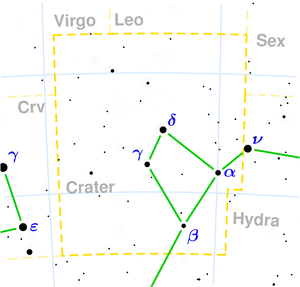|
|
Crater ( Latin: cup) is one of the 88 modern constellations and was also one of the 48 listed by Ptolemy. It is said to represent the goblet of Apollo. It has no star brighter than fourth magnitude. Notable features γ Crateris is a close double star, with a PA of 96° and a separation of 52". The fainter companion is magnitude 9.6. This system is located 84 light years from the Sun. R Crateris is a semi-regular variable of type SRb and a spectral classification of M7. It has a magnitude of 9.8-11.2 and an optical period of 160 days. SZ Crateris is a magnitude 8.1 variable star. It is a nearby star system located about 44 light years from the Sun. It is also identified as Gliese 425, and in the past it was known as Abt's Star. Notable deep sky objects NGC 3511 is a spiral galaxy with a slight bar, seen nearly from the edge, of type SBbc. It is a member of the galaxy cluster Abell 1060. This galaxy is magitude 12, and is 4' × 1' in size. NGC 3887 is a barred-spiral of type SBc, magnitude 11, with a diameter of 3.5'. NGC 3981 is a spiral galaxy with two wide spiral arms, of type SBbc. It is magnitude 12 with a diameter of 3'. This galaxy was discovered by William Herschel in 1785. Named Stars * Bayer....Name......Origin......Meaning * α........Alkes........Arabic.....name of constellation * β........Al Sharas..Arabic......the rib Mythology In Greek mythology, a crow/raven serves Apollo, and is sent to fetch water, but it rests lazily on the journey, and after finally obtaining the water in a cup, takes back a water snake as well, as an excuse. According to the myth, Apollo saw through the fraud, and angrily cast the crow, cup, and snake, into the sky. The origin of this story is likely to be the juxtaposition of this constellation with those of Corvus (constellation), and Hydra (constellation), in the area of the sky known as the Sea. References * Ian Ridpath and Wil Tirion (2007). Stars and Planets Guide, Collins, London. ISBN 978-0007251209. Princeton University Press, Princeton. ISBN 978-0691135564. * Richard Hinckley Allen, The Stars, Their Lore and Legend, New York, Dover.
Links
Retrieved from "http://en.wikipedia.org/"
|
|
||||||||||||||||||||||||||||||||||||||||||||||||||||
